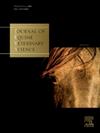Capacitation of frozen-thawed semen improves ICSI-outcomes in horses
IF 1.3
3区 农林科学
Q2 VETERINARY SCIENCES
引用次数: 0
Abstract
The first report of a repeatable in vitro fertilization (IVF) protocol for fresh semen in horses in 2022 (Felix.et.al., Biology of Reproduction. 2022; 107(6): 1551-1564) paved the way for exploring capacitation applications in equine semen. The effect of equine sperm capacitation prior to intracytoplasmatic sperm injection (ICSI) on subsequent embryo development remains to be determined. In this study, 145 cumulus-oocyte complexes (COC's) were collected from slaughterhouse-derived ovaries and matured for 30-32 hours in TCM-199 with Earl's salts containing 10% (v/v) FBS and 10 µg/mL follicle stimulating hormone and 2 µg/mL luteinizing hormone (StimufolⓇ, Reprobiol, Ouffet, Belgium). After maturation, the COCs were denuded and the ones showing an extruded polar body were fertilized with piezo-drill ICSI. Half of the mature oocytes (N = 31) were injected with frozen-thawed (FT) semen that was first selected with a sperm separation device (VetCountⓇ Harvester; MotilityCount ApS, Copenhagen, Denmark) and then capacitated in FERT-TALP with penicillamine, hypotaurine and epinephrine (Felix et al., 2022) for 10 hours. The remaining oocytes (N = 33) were subjected to control ICSI with FT-semen that was washed and centrifuged in G-MOPS (Vitrolife, Londerzeel, Belgium). The same batch of frozen-thawed semen was used for both techniques. All presumed zygotes were cultured individually in GlobalⓇ medium (LGGG-050, LifeGlobal, Guilford, CT, USA) with 10% (v/v) FBS for 5 days, after which they were transferred to DMEM/F-12 containing 10% (v/v) FBS. Cleavage rates were assessed 36h after fertilization, and blastocyst formation was assessed between day 7 and 10 post-ICSI. Statistical analyses were performed using a Fisher's exact test. Cleavage and blastocyst rates were higher for ICSI with capacitated semen (29/31 (93.5%) and 20/31 (64.5%)) than for control ICSI (24/33 (72.7%) and 12/33 (36.4%), respectively) (P = 0.03 and P = 0.02). Capacitation of semen before ICSI could improve commercial ICSI results, but more research is needed to confirm these results and to assess suitability of different stallions for capacitation of FT semen.
冻融精液的获能可改善马的icsi结果
2022年,马的新鲜精液可重复体外受精(IVF)方案的第一份报告(felix等)。生殖生物学;2022;107(6): 1551-1564)为探索能化在马精液中的应用铺平了道路。马精子获能前的卵浆内精子注射(ICSI)对随后的胚胎发育的影响仍有待确定。在这项研究中,从屠宰场衍生的卵巢中收集了145个卵母细胞复合物(COC),并在含有10% (v/v) FBS和10µg/mL促卵泡激素和2µg/mL促黄体激素(StimufolⓇ,rebiol, Ouffet,比利时)的Earl's盐的cmc -199中成熟30-32小时。成熟后,剥去COCs,挤压极体的COCs用压钻ICSI受精。一半的成熟卵母细胞(N = 31)注射冻融(FT)精液,这些精液首先通过精子分离装置(VetCountⓇHarvester;然后用青霉胺、次牛磺酸和肾上腺素(Felix et al., 2022)在FERT-TALP中充能10小时。剩余卵母细胞(N = 33)与ft -精液进行对照ICSI,经G-MOPS (Vitrolife, Londerzeel, Belgium)洗涤并离心。这两种技术使用的是同一批冷冻解冻精液。所有假定的受精卵在含有10% (v/v) FBS的GlobalⓇ培养基(LGGG-050, LifeGlobal, Guilford, CT, USA)中单独培养5天,之后转移到含有10% (v/v) FBS的DMEM/F-12培养基中。在受精后36小时评估卵裂率,在icsi后第7天至第10天评估囊胚形成。采用Fisher精确检验进行统计分析。卵裂率和囊胚率分别为29/31(93.5%)和20/31(64.5%),高于对照组(24/33(72.7%)和12/33 (36.4%)(P = 0.03和P = 0.02)。在ICSI之前对精液进行容能可以改善商业ICSI结果,但需要更多的研究来证实这些结果,并评估不同种马对FT精液的容能性。
本文章由计算机程序翻译,如有差异,请以英文原文为准。
求助全文
约1分钟内获得全文
求助全文
来源期刊

Journal of Equine Veterinary Science
农林科学-兽医学
CiteScore
2.70
自引率
7.70%
发文量
249
审稿时长
77 days
期刊介绍:
Journal of Equine Veterinary Science (JEVS) is an international publication designed for the practicing equine veterinarian, equine researcher, and other equine health care specialist. Published monthly, each issue of JEVS includes original research, reviews, case reports, short communications, and clinical techniques from leaders in the equine veterinary field, covering such topics as laminitis, reproduction, infectious disease, parasitology, behavior, podology, internal medicine, surgery and nutrition.
 求助内容:
求助内容: 应助结果提醒方式:
应助结果提醒方式:


